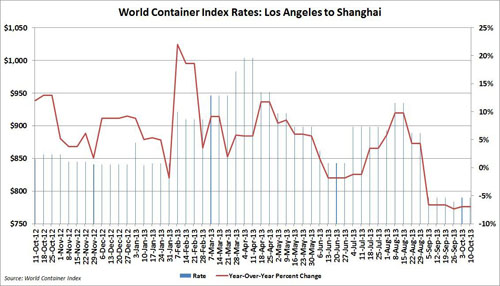Shipping lines that carry U.S. exports to Asia intend to increase their freight rates by $100 to $200 per-40-foot container unit on certain cargoes effective Nov. 15.
TSA Westbound members are recommending a Nov. 15 increase in rates by $100 per 40-foot container via U.S. West Coast ports and $200 per FEU via East and Gulf Coast ports, and $100 for intermodal shipments, for six commodities — waste paper, metal scrap, plastic scrap and resin, lumber and logs, hay and agricultural products. For waste paper specifically, the carriers adopted guidelines on rate levels for shipments via California ports that may entail additional increases.

Weekly rate changes for shipments from Los Angeles to Shanghai since October 2012.
The guidelines are intended to be flexible, reflecting actions already taken by some carriers in October and different carrier views on the levels of increase achievable in different lane segments, according to Brian Conrad, TSA executive administrator.
Conrad noted that the westbound trade to Asia is entering its peak season. During the slack season that is now coming to an end, the trade has experienced steady rate erosion, he said.
Rates for U.S. export trade to Asia have been steadily declining in recent months. According to the World Container Index, trans-Pacific westbound rates from Los Angeles to Shanghai hit their lowest levels since February 2012 in September, and have seen little relief since then, increasing by just $6 so far this month, despite plans to increase rates by $100 per FEU on Oct. 1.
Members of the TSA have also recommended a Nov. 15 rate increase in the eastbound trans-Pacific.
TSA Westbound, a forum for 15 container lines serving trade from Asia to ports and inland points in the U.S., includes the following members: APL, China Shipping Container Lines, CMA CGM, Cosco Container Lines, Evergreen Line, Hanjin Shipping, Hapag-Lloyd, Hyundai Merchant Marine, “K” Line, Maersk Line, Mediterranean Shipping Co., NYK Line, OOCL, Yang Ming Marine Transport and Zim Integrated Shipping Services.
The Journal of Commerce




.jpg)









